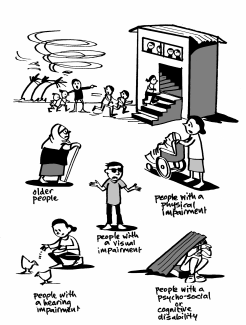Barriers
**COVID-19 specific information**
Accentuation of barriers to access health, social-economic support and wider participation are increasingly seen linked to COVID-19 responses. Pay specific attention to:
- Deprioritization of persons with disabilities for available health services: triage protocol must not discriminate on the basis of disability, age or gender for access to life saving health care and treatment.
- Make sure that emergency responses do not lead to disruption of vital social services (e.g. personal assistance, rehabilitation), insurance schemes and essential medicines for persons with disabilities. Therefore, ensure services delivery include persons with disabilities during your assessments, any type of distributions or cash transfer, and throughout the whole response implementation, including monitoring and evaluation.
- Increased stigmatization and prejudice towards persons with disabilities. For example, some people may refuse care to persons with disabilities due to fear of contracting COVID-19, or assume that persons with disabilities cannot continue in their current activities or jobs and make their own decisions in relation to exposure risk.
- Make sure to include advocacy actions that address stigma and raise awareness on the rights of persons with disabilities when engaging in new partnerships, and include DPO in these actions.
*****************
Barriers are obstacles which prevent people from fully participating in society. They can be environmental (which include physical barriers and communication barriers), attitudinal or institutional. Many barriers exist in our everyday environments and the emergence of a humanitarian emergency can be an opportunity to take effective and sustainable actions to break them down.

©Julie Smith
Sources
ADCAP - CBM, Help Age and Handicap International. Humanitarian inclusion standards for older people and people with disabilities, 2018.